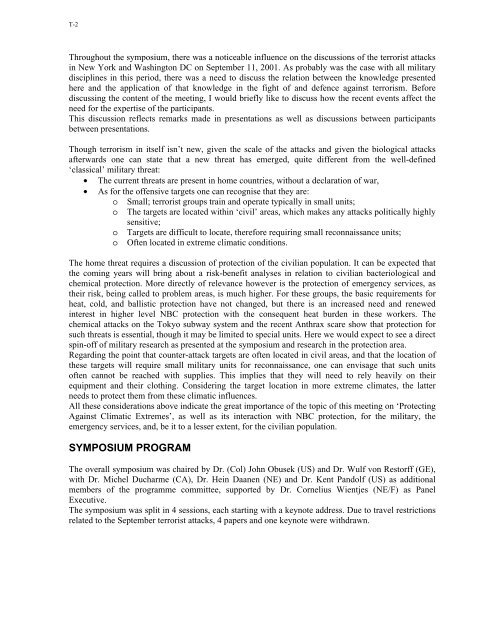Technical Evaluation Report - Nato
Technical Evaluation Report - Nato
Technical Evaluation Report - Nato
Create successful ePaper yourself
Turn your PDF publications into a flip-book with our unique Google optimized e-Paper software.
T-2<br />
Throughout the symposium, there was a noticeable influence on the discussions of the terrorist attacks<br />
in New York and Washington DC on September 11, 2001. As probably was the case with all military<br />
disciplines in this period, there was a need to discuss the relation between the knowledge presented<br />
here and the application of that knowledge in the fight of and defence against terrorism. Before<br />
discussing the content of the meeting, I would briefly like to discuss how the recent events affect the<br />
need for the expertise of the participants.<br />
This discussion reflects remarks made in presentations as well as discussions between participants<br />
between presentations.<br />
Though terrorism in itself isn’t new, given the scale of the attacks and given the biological attacks<br />
afterwards one can state that a new threat has emerged, quite different from the well-defined<br />
‘classical’ military threat:<br />
• The current threats are present in home countries, without a declaration of war,<br />
• As for the offensive targets one can recognise that they are:<br />
o Small; terrorist groups train and operate typically in small units;<br />
o The targets are located within ‘civil’ areas, which makes any attacks politically highly<br />
sensitive;<br />
o Targets are difficult to locate, therefore requiring small reconnaissance units;<br />
o Often located in extreme climatic conditions.<br />
The home threat requires a discussion of protection of the civilian population. It can be expected that<br />
the coming years will bring about a risk-benefit analyses in relation to civilian bacteriological and<br />
chemical protection. More directly of relevance however is the protection of emergency services, as<br />
their risk, being called to problem areas, is much higher. For these groups, the basic requirements for<br />
heat, cold, and ballistic protection have not changed, but there is an increased need and renewed<br />
interest in higher level NBC protection with the consequent heat burden in these workers. The<br />
chemical attacks on the Tokyo subway system and the recent Anthrax scare show that protection for<br />
such threats is essential, though it may be limited to special units. Here we would expect to see a direct<br />
spin-off of military research as presented at the symposium and research in the protection area.<br />
Regarding the point that counter-attack targets are often located in civil areas, and that the location of<br />
these targets will require small military units for reconnaissance, one can envisage that such units<br />
often cannot be reached with supplies. This implies that they will need to rely heavily on their<br />
equipment and their clothing. Considering the target location in more extreme climates, the latter<br />
needs to protect them from these climatic influences.<br />
All these considerations above indicate the great importance of the topic of this meeting on ‘Protecting<br />
Against Climatic Extremes’, as well as its interaction with NBC protection, for the military, the<br />
emergency services, and, be it to a lesser extent, for the civilian population.<br />
SYMPOSIUM PROGRAM<br />
The overall symposium was chaired by Dr. (Col) John Obusek (US) and Dr. Wulf von Restorff (GE),<br />
with Dr. Michel Ducharme (CA), Dr. Hein Daanen (NE) and Dr. Kent Pandolf (US) as additional<br />
members of the programme committee, supported by Dr. Cornelius Wientjes (NE/F) as Panel<br />
Executive.<br />
The symposium was split in 4 sessions, each starting with a keynote address. Due to travel restrictions<br />
related to the September terrorist attacks, 4 papers and one keynote were withdrawn.

















